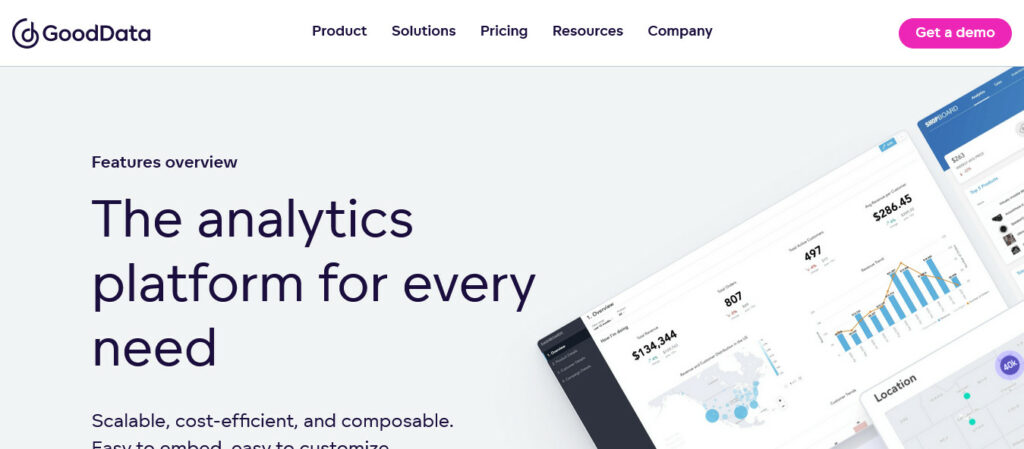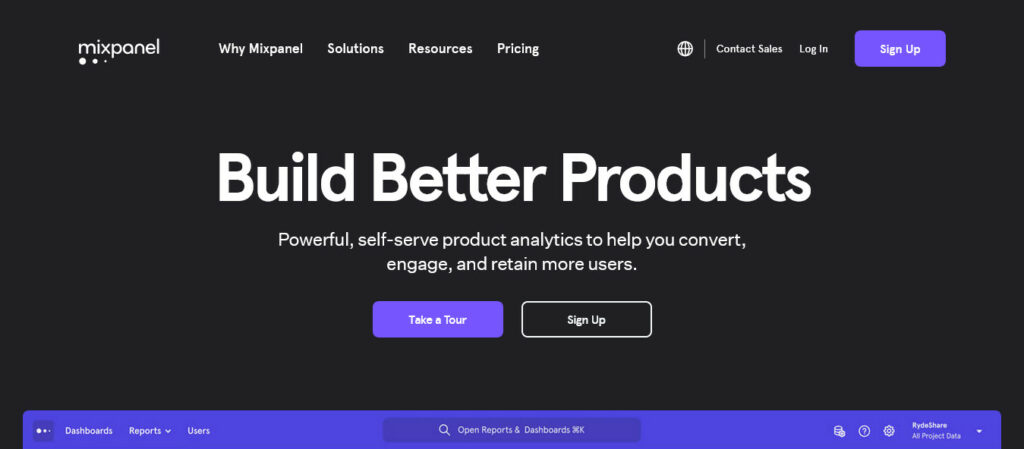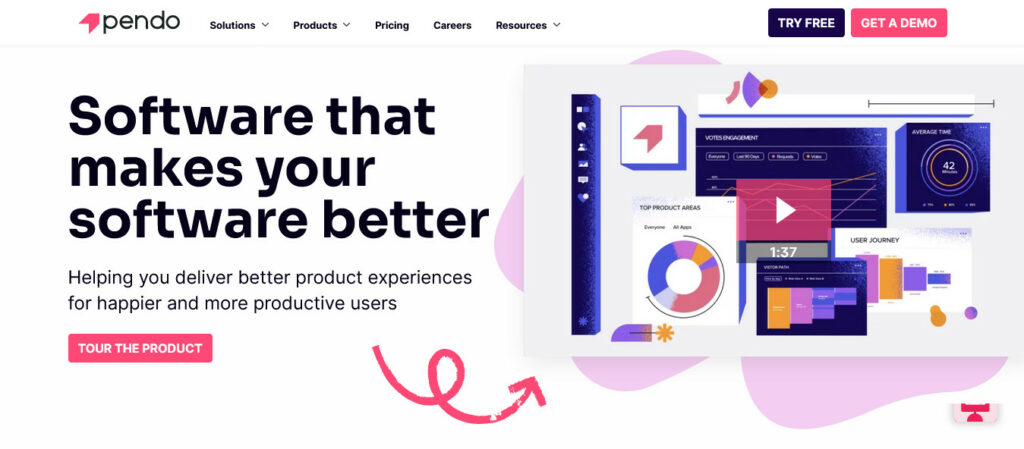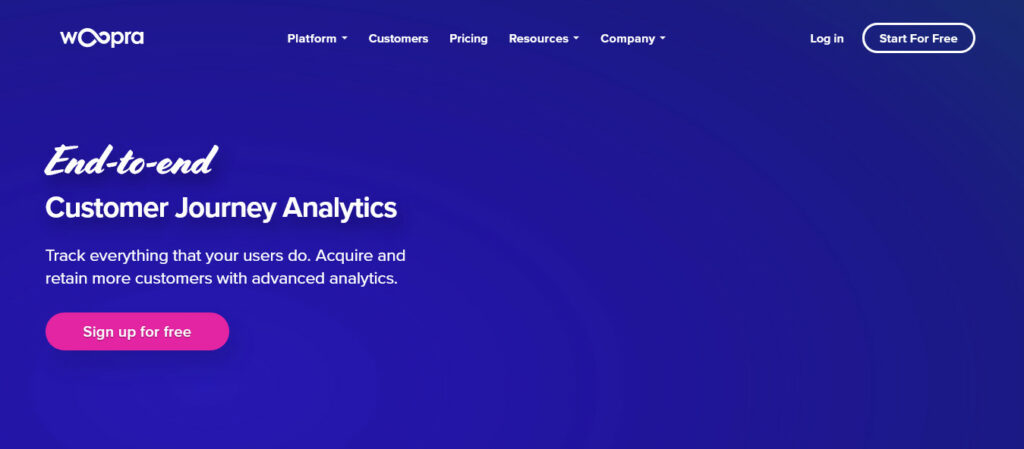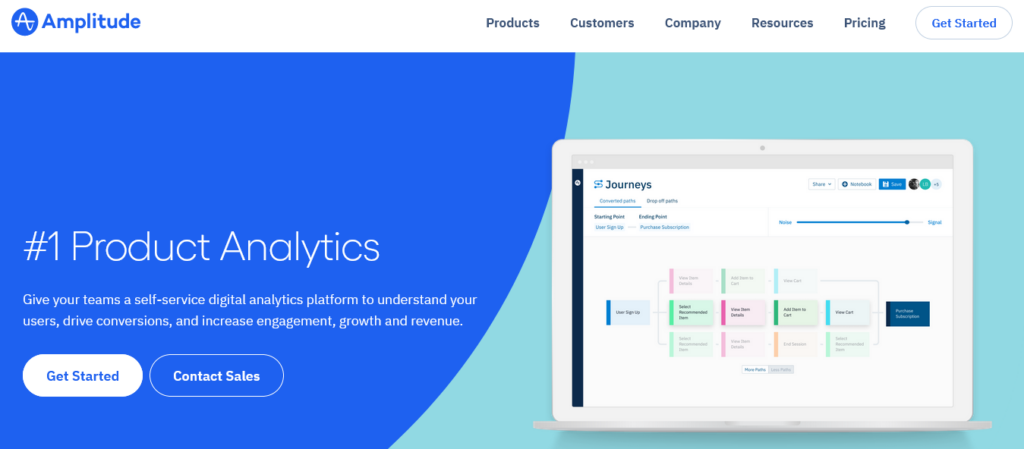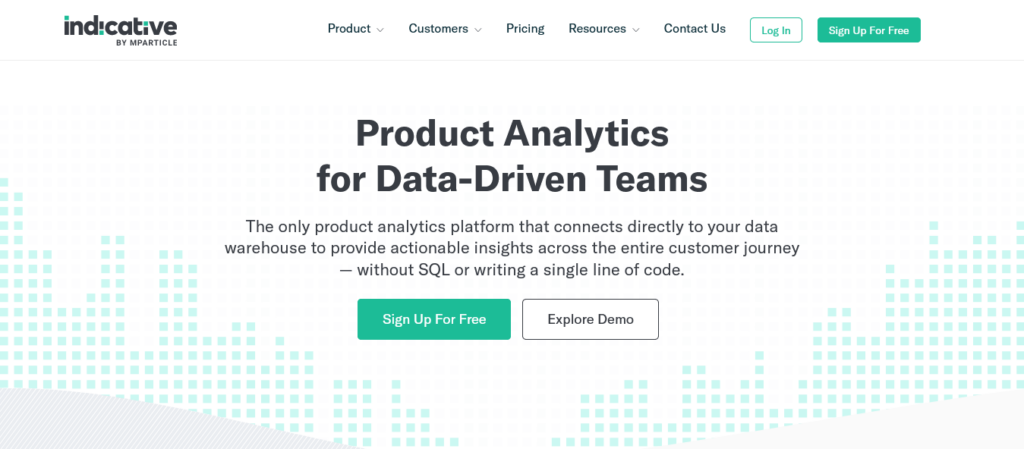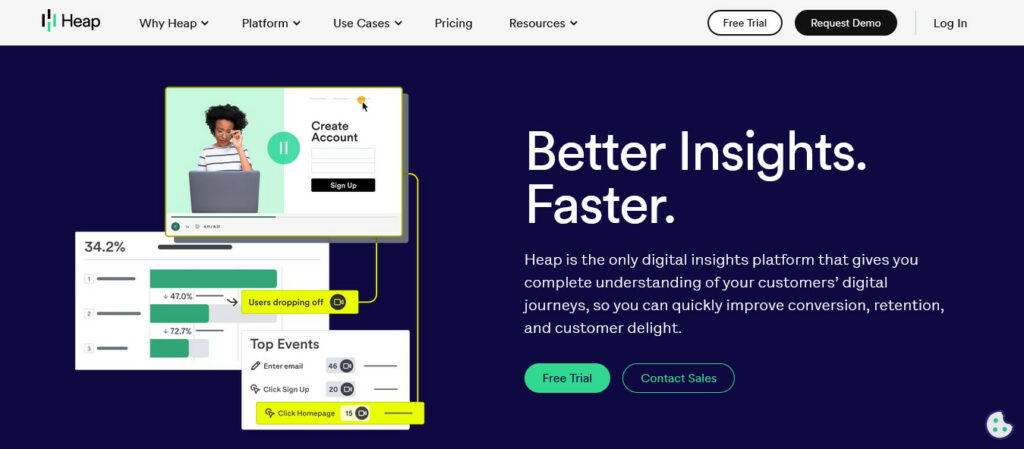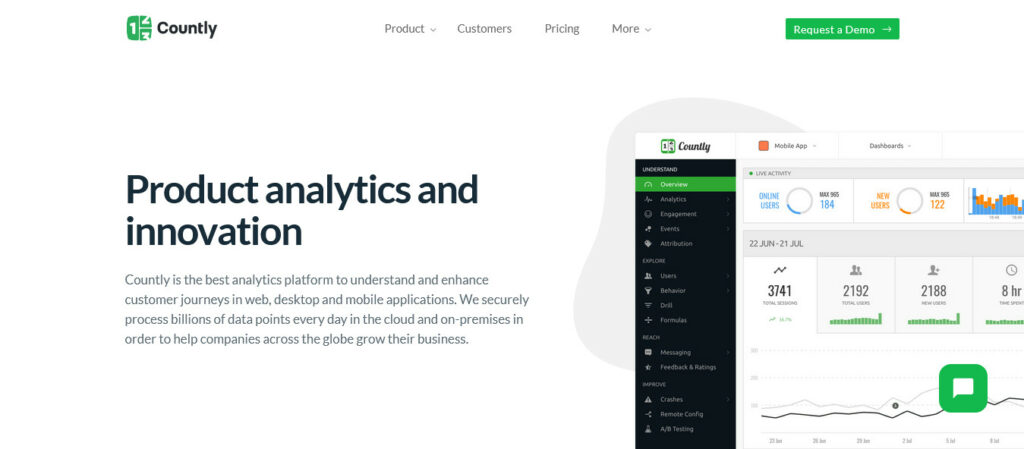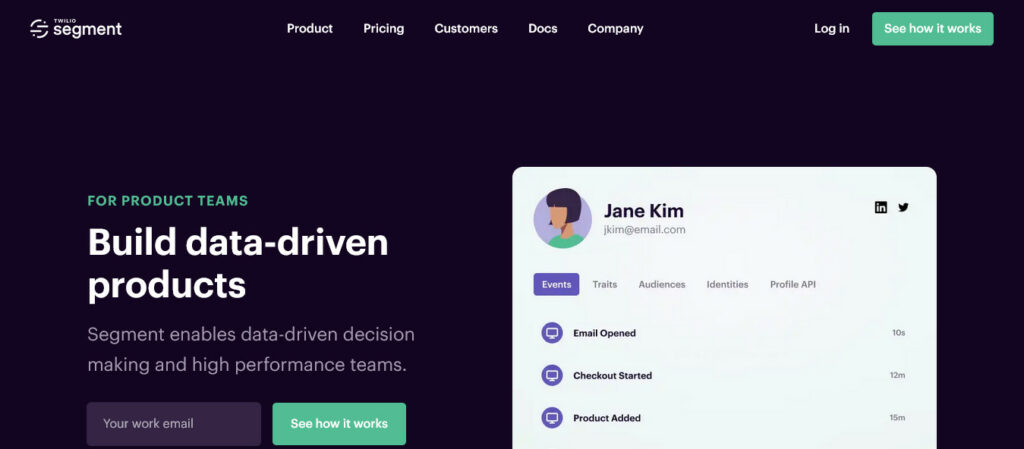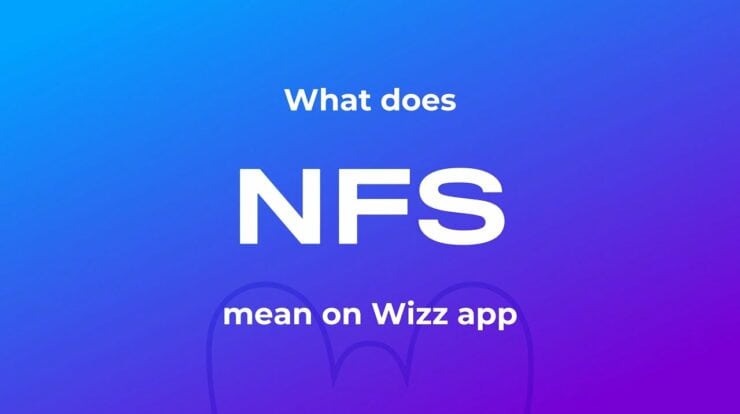
Product analytics software assists managers and product owners analyze product performance in terms of key performance indicators, such as visits, engagement, interactions, behavior patterns, and so on, to improve the entire product experience and meet business goals. The primary goal of product analysis software is to deduce product benefits from data via engaging users.
Product Analytics Vs. Web Analytics
Product analysis and web analytics assist businesses in meeting their objectives; however, their approaches vary greatly. The Product analysis focuses on a company’s products or services and gathers data from many sources to determine customer behavior. This approach is designed to provide decision-makers insight into how customers engage with the product and to help them improve the product or service.
Data insights from product analytics software are used to illustrate correct customer behavior. Facts based on this data may be used to improve user experience and features, improve your roadmap with user demands and boost acceptability and conversions. They may also supply insightful information, tools for increased automation and visualization, and various other services. Web analytics tracks and evaluates how people (web traffic) arrive at a website and navigate its pages. These steps improve website efficiency, expand business reach, and optimize online use.
Google Analytics (GA) Vs. Product Analytics (PA) Software
Google Analytics (GA) is a web analytics software. It monitors particular user behavior on a website and gives analytics like as page views, sessions, unique visitors, average time per page, and so on. Undoubtedly, GA gives excellent free data that assist website owners in optimizing their websites for increased online traffic. On the other hand, product Analytics (PA) employs more realistic user behavior data, while GA analyses anonymous traffic.
Some Limitation Of Google Analytics (GA) Over Product Analytics (PA) Software
1 – GA offers an overall overview of the event, making it impossible to determine what users were doing before and after the drop point.
2 – Non-HTML content cannot be tracked, such as PDF downloads, video views, form submissions, etc.
3 – No raw data access: GA gives difficult-to-analyze custom data for comprehensive insights.
4 – Data visibility issues are caused by certain users disabling cookies and JavaScript in their browsers, limiting the usage of Google Analytics collection tags, libraries, and SDKs. Exact figures may be found on Google’s website.
5 – GA does not support processing PII (Personally Identifiable Information) data. As a result, determining the value, specific users obtain from your product takes time and effort.
6 – There is no specific customer care or support in GA.
7 – PA offers your users important information based on broken features and assists in the optimization of efficient features. You can engage customers for longer, retain them, and sell more if you understand what they do, how they interact with features, and what they like best about your product.
There are other features and benefits of using PA, which we shall describe in the next section.
How Do You Choose The Best Product Analytics Software To Get The Required Results?
The best software is dependent on the product or service category, but in general, the following seven elements will assist you in selecting the best one that meets your needs:
Custom Event Tracking – Capture custom events like button clicks, form fills, page views, etc.
Automatic Retrieval – It relieves manual tracking teams by eliminating the requirement to pick which events to track in advance. It also aids in the tracking of trends.
Low Code Reliability – Makes it easy to incorporate tracking code and makes management easier for non-technical people.
Detention Reporting – Assist in predicting customer retention based on consumer activities, paths, and processes.
Segmentation – This enables data to be evaluated based on specified parameters such as demographics, usual behavior, and so on.
Third-party Integrations – For improved optimization, visualization, and automation that benefits the whole team, such as B. Marketing, Sales, Customer Success, Product Management, and so on.
Real-time Data – Software that delivers real-time information is better than software that takes many hours to read the data on the dashboard.
Product Analytics Software Importance
Because most apps are not built to create extensive reports on their own, product analysis is an essential aspect of a company’s product management approach. Usage data is often misconstrued and unreliable in the absence of analytics. Product analytics software makes unstructured data usable by combining all data sources into one organized perspective. Here are a few additional benefits of PA:
Quality Data – Product analysis platforms enable product teams to examine information in more detail than is feasible with human error-prone interviews, surveys, and conversations.
Features Implementation – While integrating product analytics may help businesses understand how their customers use current product features, it can also assist companies in testing new features and evaluating user experience. When a team has a goal for how many new features to employ, they may use the data supplied by product analytics to strive towards that goal.
Customer Retention – In recent years, app development technology companies have found that product analysis is one of the most successful strategies to boost customer retention and maximize a company’s position in a competitive market.
Let’s take a look at some of the best product analytics tools.
8+ Best Product Analytics Software You Can Use
Product Analytics Software you can use in 2022.
1. GoodData
GoodData offers a BI (Business Intelligence) platform for creating and delivering product analysis that aids in developing data strategies for building new products to boost a company’s ROI (Return on Investment). Without any training, easy-to-use, adaptable dashboards enable any manager to create their own new reports and personalize visualizations, dashboards, and more. In addition, its adaptable design enables organizations to integrate with existing infrastructure and offer analytical solutions to workers, customers, and business partners.
Integration with multiple data warehouses and databases is also feasible, including AWS Redshift, BigQuery, Snowflake, PostgreSQL, and Vertica. GoodData ensures the greatest degree of data protection by using industry best practices and cutting-edge technology. This platform employs numerous levels of security by worldwide standards such as GDPR-S, SOC2, PII, ISO, CCPA, and others.
Features
1 – Use Enterprise Security and Shield to safeguard business and consumer data.
2 – Easily incorporate dashboards, charts, and analytics with iframes.
3 – The platform is available both on-premises and in the cloud.
4 – Scalability may occur in all dimensions, such as data volume, cost, and users, without losing data speed or IT flexibility.
GoodData is available for free for a limited time of 5 workspaces. Pricing is based on features and data volume rather than users or queries.
2. Mixpanel
Mixpanel lets you understand user behavior to make better choices about your SaaS apps. It offers event-based product analysis, which analyses particular user interactions in real-time to spot patterns and understand customer behavior efficiently. Because user data protection is critical, this software includes privacy tools for data compliance and international data transfer regulations, including GDPR, CCPA, HIPAA, and others. In addition, its event-based method captures a more precise picture of user engagement, allowing for more detailed analysis and more effective message and experiment targeting.
To secure customer privacy, the software team uses development methodologies such as built-in SOC 2 Type II certification, role control, and enhanced encryption. In addition, interactive reports provide extensive visualization of user-specific data such as which users remain for how long, grouping users by behavior, correlating user behavior to long-term retention, where and why customers left, and so on. Finally, the detailed level analysis comprises user concepts, events, and properties to offer in-depth and appropriate analysis of user-specific tasks. The following are some examples of users, events, and properties.
Features
1 – Impact report to determine the launch’s success.
2 – Create custom properties using simple formulae without the requirement for development staff.
3 – Sync Mixpanel data with the remainder of your interoperability stack with ease.
4 – Dashboards provide an overview of product uptake, retention, or other custom metrics.
5 – Determine essential user paths to reduce friction.
Mixpanel is a simple yet effective product analysis software that may help you convert, engage, and retain more users. A free version is provided to the first 100,000 users.
3. Pendo
Pendo assists businesses in understanding how customers perceive their product qualities and how multiple paths through the product lead to improved business insights. It is used to expand the adoption of software products by Fortune 500 companies, B2B technology startups, educational institutions, and healthcare systems. Its distinguishing feature is that it blends in-app messaging with strong product analysis and user feedback, allowing individuals to adapt effectively to the software with little effort.
This platform enables product teams to collaborate on qualitative and quantitative information in order to make educated customer support choices across the product experience. In summary, Pendo assists companies in gaining an overview of their products, such as which features customers use and disregard. Which choice is the best to choose, and which characteristic causes friction, and so on? This will create the company in removing customer pain customers and developing new products. To maximize product value, the platform also assists in organizing in-app messaging, manuals, and instructions without coding.
Features
1 – Simple and quick user orientation also helps in goal setting to match business goals.
2 – Easily track, record, and prioritize feature requests from customers.
3 – Data insights to understand customer behavior and identify revenue-generating activities.
4 – Comprehensive customer support systems that increase customer happiness while lowering expenses and increasing customer competence.
Pendo software assists companies in providing better product experiences for happier, more productive users by encouraging innovation. It is free to use for up to 1000 active users each month.
4. Woopra
Woopra is a cutting-edge customer analytics software that produces real-time data on consumer behavior. It assists companies in analyzing customer lifecycles by automatically developing complete profiles. Centralized views provide granular customer journey data like web activity, page views, device type, email activity, help desk, payments, support, and many more customer activities. Its customizable reports assist companies in examining customer touchpoints and associated outcomes in order to show brand equity and encourage product innovation. In addition, the Woopra platform enables third-party tools such as Dropbox and Mailchimp to connect business data and communicate insights across several teams inside an organization.
Features
1 – Three-dimensional models to show customers data that is seldom seen in the equation.
2 – Automatically track an infinite number of custom activities.
3 – Based on user behavior data, dynamic triggers may be built.
4 – Schedule accounts for sophisticated automatic operations such as data sync, email list export, subscription addition/update, and more.
Through behavioral data analysis, the Woopra platform provides a unique user experience to marketing and support teams in order to meet corporate goals. The software is free for up to 500,000 activities every month, after which you will be invited to upgrade.
5. Amplitude
Amplitude is a pioneer in digital product intelligence and a $2 billion Nasdaq-listed company. It is rated first in G2 Product Analytics and is used by 26 Fortune 100 companies. The primary goal of amplitude analysis is to understand customers in terms of behavior, personality, and engagement and to improve their experience by finding friction spots and tracking their trips. It examines outcomes by gaining a better knowledge of conversions and enhancing customer retention via product innovation. The platform links digital products to customers directly. It adds value to digital investments by understanding indications beyond the surface level (page views and clicks), such as user characteristics, most used features, high-value customers, people engagement, conversion, and so on.
Features
1 – Behavioral Cohorts to gain a more accurate picture of user behavior.
2 – Simple interaction with third-party platforms such as Amazon, AppsFlyer, Apptimize, Google Play, iTunes, mParticle, and others.
3 – Industry-leading data management and compliance standards assure data security and dependability.
4 – Baseline indicators are useful for study, learning, and forecasting.
5 – Machine learning (ML) to forecast outcomes over time and determine the possibility of customers purchasing, rejecting, and so on.
Product managers, merchants, and developers should use this top digital product intelligence software. The free edition monitors 10 million activities monthly and allows unlimited user location and data storage.
6. Indicative
Indicative is a platform for product analytics that provides a unified picture of the customer experience across all data sources and marketing channels. Because of the architecture’s scalability, you may connect to your current data sources through storage/lake, CDP, or directly from your website or mobile app. Its proprietary multi-funnel technology visualizes and predicts which customers are critical to acquiring and identifies friction spots across multiple customer groups for retention. In addition, the software tracks the customer journey from beginning to end, including common paths, mapping to understand customer behavior, building funnels for customer movement in products, understanding friction points where customers fail, and a variety of other indicators that aid in the creation of better products and increasing customer satisfaction.
Features
1 – Key Performance Indicators (KPIs) may be tracked and shared across teams.
2 – Completely personalized dashboard with automatic updates.
3 – Various segmentation for analyzing customer behavior.
4 – Conducting a group analysis to allow and detect the recurrent customer behavior.
The indicative platform, which startups and companies of all sizes trust, best suits product managers, merchants, and data analysts. The ordinary edition is free for the first three users and provides 25 million events each month.
7. Heap
Heap comprises three major components: data analysis, data foundation, and data management. These three pillars assist in determining who uses the product, segment interactions, identify product friction that leads to product enhancement, stimulate, activate, and maintain conversions, and obtain early indications for customer behavior change. Because the Heap automatically accumulates all user interactions, there is no need to alter code when new features or reductions are implemented. The data model is extensive, including funnel analysis, retention analysis, user segmentation, behavioral groupings, and other features that aid in the creation of more useful products that match business goals.
Features
1 – Improved data tracking and analysis to track the full customer journey.
2 – Event Viewer lets you define events without changing raw data sets.
3 – Rather than determining which events to track in advance, automatic data gathering collects customer interactions.
4 – Create custom reports and easily add them to the dashboard.
Without a technical staff, Heap is one of the simplest platforms to set up for smaller and enterprise-level apps. With an unlimited user license, this software may be used for free for up to 10,000 sessions each month.
8. Countly
Countly is the world’s premier product analytics platform, assisting in tracking product performance and measuring innovation to improve customer experience and satisfy business objectives. Its extensive reach records over 1.5 billion unique identities across more than 16,000 apps and employs over 2,000 servers globally. Its revolutionary platform collects real-time app use and click behavior from mobile, desktop, web apps, and websites and visualizes analytics to evaluate user behavior. On the dashboard, real-time data such as views, entrance and exit pages, bounces, page time, heatmaps, and so on are tracked and forecasted. In addition, numerous plugins relating to user profiles, sophisticated segmentation, behavior analysis, alerts, and so on may be included to expand the software’s functionality and usability.
Features
1 – Custom building segmentation based on company requirements.
2 – It may be used in a corporate or private cloud environment.
3 – Verifying data integrity via a checksum technique.
4 – The app’s health and productivity counter monitors crashes and faults.
The Community Edition is free to use but needs server hosting at a cost, while the Enterprise Edition includes premium plugins and custom SLAs and may be hosted on-premises or in the cloud.
9. Segment
The Segment is used to gather data from different sources for the marketing and engineering teams to understand the customer journey to build creative products and track customer behavior to accomplish goals. The unified dashboard gathers customer touchpoints from all resources to create results-driven journeys such as continuous engagement, results-driven journeys, and omnichannel messaging.
Create real-time behavioral campaigns and analyze real-time data segments to target the correct customers. One of the platform’s primary tasks is to ensure the security and confidentiality of customer data, which is handled using the best secure protocols, data encryption, domain identity management (SCIM), and multi-factor authentication (MFA), to mention a few. Without any coding concerns, data collecting may be sent to 300+ different real-time marketing tools.
Features
1 – A basic analytics API may capture user events from any website, app, or repository.
2 – Data sharing dictionaries can synchronize almost any organizational team.
3 – Real-time privacy evaluation in accordance with regulations such as GDPR, CCPA, and others.
4 – Customer profiles may be segmented based on intent alerts based on real-time customer behavior with real-time stress lists.
The Segment platform has been certified to industry standards such as ISO 27001, 27017, SOC 2 Type 2, and others. The platform is free for a limited time; however, it only enables 1000 visits per month from two sources with 300+ integrations.
Final Words: Product Analytics Software
The product analysis software mentioned above works best and produces excellent findings. However, each tool is distinct and has its own set of features. Because no one tool can capture all functions, it is critical to determine the unique demands of the organization or product, as well as the business goals, and then choose the proper product analysis software.
